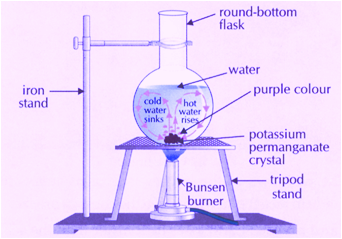Convection Currents in Water: A Heat Movement Study
Activity 3.8: Convection of Heat in Water demonstrates how heat is transferred through liquids, focusing on the concept of convection.
Objective
To observe and understand the process of convection in liquids, specifically in water.
Materials Needed
- A small pan or beaker
- Water
- A crystal of potassium permanganate
- A straw
- A candle or another heat source
Steps to Follow

- Prepare the Water: Fill a pan or beaker with water.
- Add Potassium Permanganate: Place a crystal of potassium permanganate at the bottom of the flask, using a straw for precise placement.
- Heat the Water: Heat the water by placing the candle just below where the potassium permanganate is positioned.
Expected Observations
- As the water heats up, you’ll notice that the water near the flame gets hot first. This hot water will rise to the top.
- The cooler water from the sides and bottom of the beaker will then move down towards the heat source.
- This cycle continues, creating a flow in the water. This is known as a convection current.
Also Check – Chapter 3 Heat Activities: Simple Experiments for Class 7
Understanding the Concepts
- Convection in Liquids: Unlike solids, where heat is transferred through conduction, liquids like water use convection to transfer heat. Here, the molecules of water move, carrying heat with them.
- Hot Rises, Cool Sinks: Hot water rises because it’s less dense, while cooler water sinks as it’s denser. This cycle of rising and sinking creates convection currents, effectively distributing heat throughout the water.
Conclusion
This activity helps you visualise how convection works in liquids. By heating water and observing the movement created by differences in water temperature, you learn a fundamental principle in physics: heat in fluids is transferred through the movement of the fluid itself, known as convection. This concept is crucial in understanding various natural and man-made processes involving liquids.
Also Check – Class 7- Chapter 3- Heat- 5 Worksheets Solved and Unsolved
Also Check – Class 7 science -Chapter 4 – Heat -Detailed Notes
Also Check – Class 7 science -Chapter 4 – Heat – Definition and Explanation of Important Keywords
Also Check – NCERT Solutions For Class 7 Science Chapter 4 – Heat
Also Check – Sea Breezes and Land Breezes – Class 7 Science explained in details
Also Check – Difference Between Sea Breeze And Land Breeze
Also Check – Conduction, Convection, and Radiation- Class 7 Science Explained
Also Check – Rapid Revision – Class 7 Science -Chapter 3 – Heat– Complete Notes

